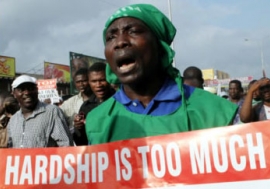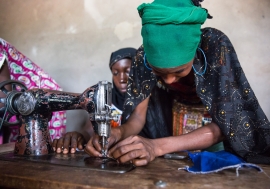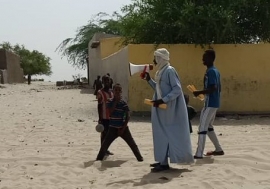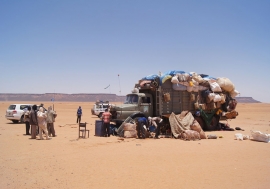Safeguarding children from armed conflict
Safeguarding children from armed conflict
 A boy soldier in the Chadian army: Both sides in the conflict have recruited children to fight, contrary to international norms.
A boy soldier in the Chadian army: Both sides in the conflict have recruited children to fight, contrary to international norms.For several years after war erupted in Côte d’Ivoire in 2002, children were recruited to fight on all sides of the conflict. But with the signing of a comprehensive peace agreement last year, such recruitment has essentially ceased, UN Secretary-General Ban Ki-moon reported to the Security Council at the end of January. Because children are no longer being conscripted, the Ivorian groups that were previously cited by name in the annexes to the Secretary-General’s annual reports on children in armed conflict have now been “delisted.”
Sierra Leone and Liberia used to have large numbers of child soldiers. But they are now at peace and are also no longer included in the report’s annexes. The Secretary-General’s Special Representative for Children and Armed Conflict Radhika Coomaraswamy calls the annexes a “list of shame,” intended to put pressure on named groups to stop such abuses.
There has been modest progress in a few other African countries. A peace accord in January between the government of the Democratic Republic of the Congo (DRC) and rebel factions in the provinces of North and South Kivu called for the demobilization of child combatants. “Each month we are welcoming some 200 child soldiers who are leaving the armed groups,” reports Ntumba Luaba, national coordinator of the DRC’s disarmament, demobilization and reintegration (DDR) programme.
However, notes the Secretary-General, all the Congolese groups listed in his previous reports “continue to recruit, use and abduct children,” and therefore remain in the annexes. These include the force of rebel General Laurent Nkunda, which increased its enlistment of child soldiers during the reporting period, as well as the government’s regular armed forces. And while the number of incidents leading to the killing and maiming of children declined in the DRC, many continued to suffer sexual abuse. In South Kivu alone, some 1,400 child victims of rape and other sexual violence received assistance from the UN and its partners in the one-year period ending June 2007.
Close scrutiny
While the impact of armed conflict on children had been recognized for some time as a major humanitarian problem, in the 1990s it also came to be seen as a peace and security question. In 1999, the UN Security Council began taking up the issue as a regular thematic item. Demobilizing child soldiers has become a normal feature of UN-organized DDR operations, and a number of UN agencies and civil society groups now systematically monitor the conditions of children in war zones.
Some of those who recruit child soldiers have been brought to justice. The Special Court for Sierra Leone has convicted several former commanders and the charge of conscripting children also has been laid against the court’s most prominent defendant, former Liberian President Charles Taylor. The International Criminal Court (ICC) in the Hague has indicted or issued warrants against rebel leaders in the DRC and Uganda, and Congolese courts have also prosecuted a number of individuals on similar charges.
“The fight against impunity through accountability for perpetrators of grave violations against children is crucial to halt these unacceptable acts,” argues Ms. Coomaraswamy.
Extensive abuses
Despite stronger action, abuses remain widespread. The number of child combatants ranges between 250,000 and 300,000 worldwide. The Secretary-General’s report draws particular attention to the vulnerability to recruitment of children in camps for internally displaced people, citing cases from Chad, the DRC, Sudan and Uganda.
The report details various kinds of mistreatment in a number of countries:
- Although most armed groups in Burundi have signed peace agreements, some continue to recruit child soldiers. Rape and other sexual violence against children by both rebels and government forces have been reported.
- In the Central African Republic several rebel forces have been conscripting children and sending them into combat, resulting in many deaths. However, an agreement involving one of the groups, the government and the UN Children’s Fund (UNICEF) led to the release of 450 children.
- Both the government and rebels in Chad have conscripted hundreds of child soldiers. Armed groups from Darfur in neighbouring Sudan that are backed by the Chadian government have also recruited children from refugee camps in Chad.
- In Sudan itself, all sides in the Darfur conflict use and abuse children. Child recruitment by former rebels in the south has continued, despite a peace accord. After a peace agreement in October 2006 between the government and a rebel group in the east, some 250 children are being demobilized there.
- In Somalia, both the Transitional Federal Government (TFG) and the Union of Islamic Courts enlisted children during the intense fighting for Mogadishu at the end of 2006. But since June 2007, the TFG, which now controls the city, has been releasing children from its ranks.
- The insurgent Lord’s Resistance Army (LRA) in Uganda has been notorious for abducting children to fight and serve as sex slaves. The LRA now operates mainly across the border in southern Sudan, from which scores of children have escaped or been rescued by Ugandan or allied southern Sudanese forces.
To counter the persistence of such practices, the Secretary-General has encouraged the Security Council to consider “targeted measures,” including sanctions, against those groups that systematically harm children. He also proposes that all future UN peacekeeping missions include child protection advisers and urges all countries to bring to justice those responsible for the military recruitment or other abuses of children.
















